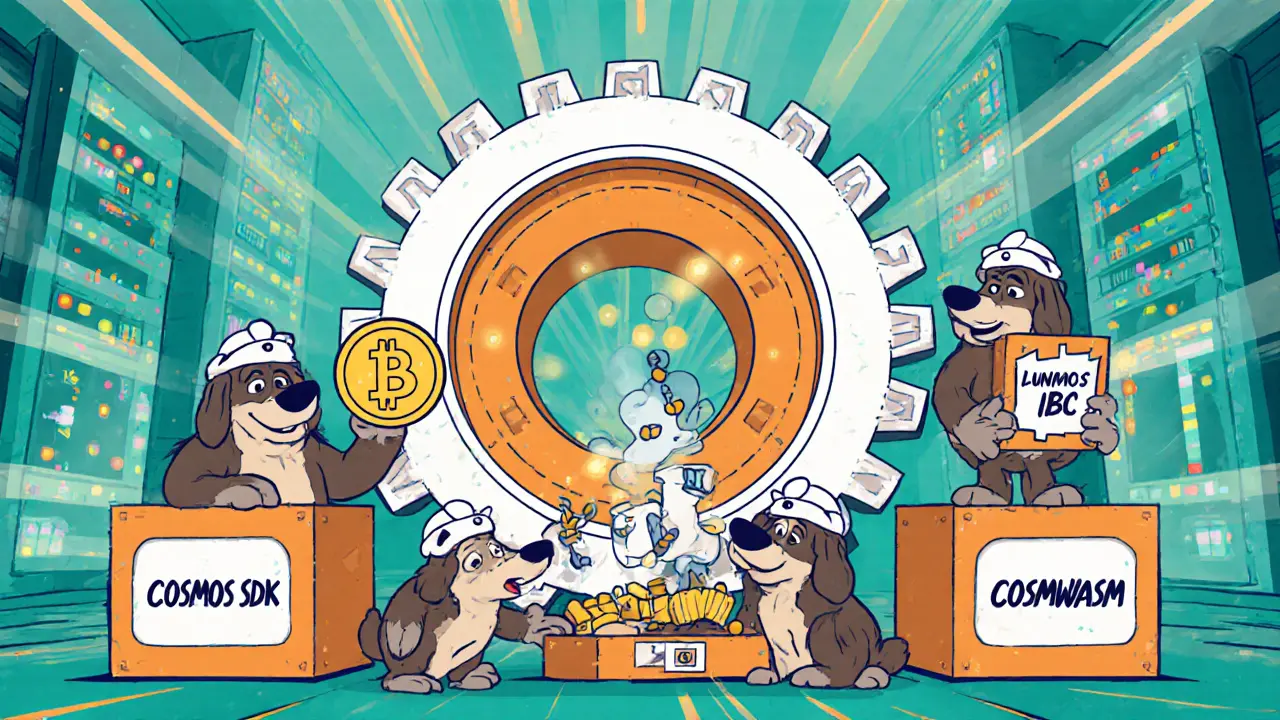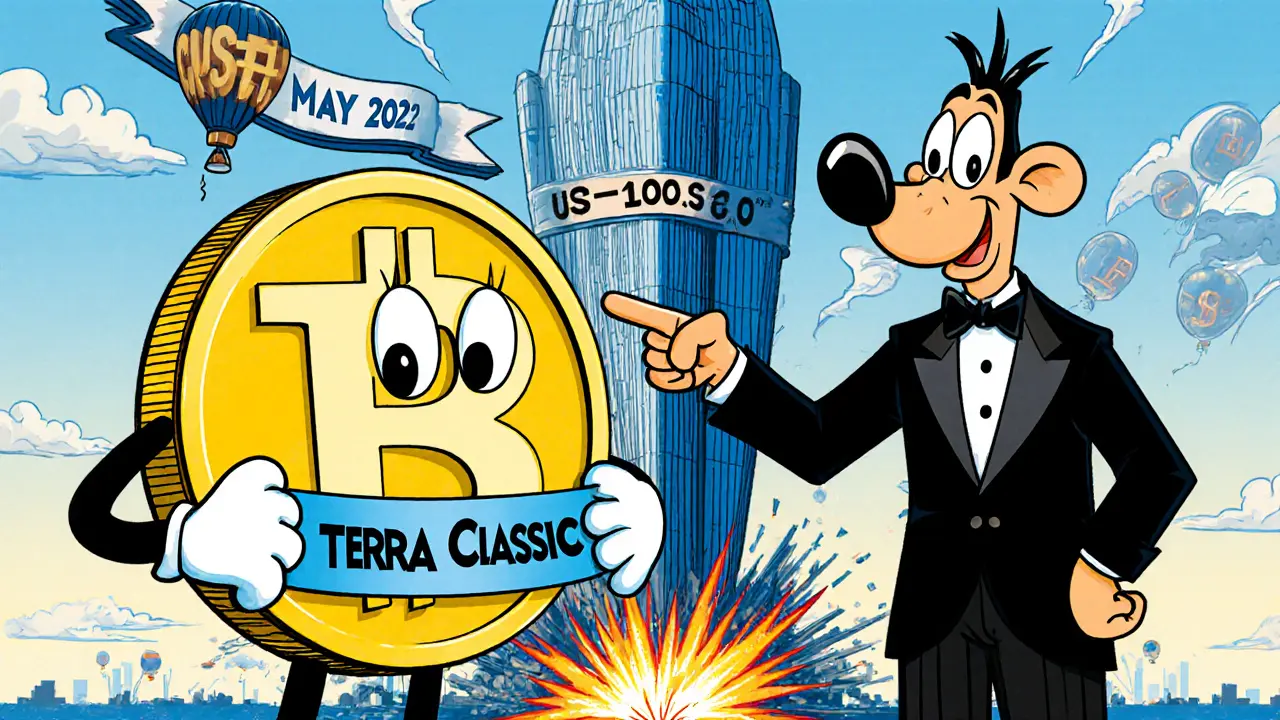LUNC Price & Supply Calculator
Current LUNC Metrics
Calculator Inputs
Projection Results
When people talk about the Terra Classic the original blockchain that survived the 2022 UST crash, its native token is known as LUNC. The token resurfaced after the original Terra chain was rebranded in May 2022, and today it sits at the crossroads of community‑driven governance, high‑volume staking, and a very large circulating supply.
Key Takeaways
- Terra Classic is the original Terra blockchain; LUNC is its native token.
- It runs on a Proof‑of‑Stake consensus, uses the Cosmos SDK, and supports CosmWasm smart contracts.
- As of Oct2025, LUNC trades around $0.000054, with a market cap near $330M.
- Price growth is limited by a supply of over 5.5trillion tokens and no hard cap.
- Community burn programs, validator voting, and the upcoming v3.5.0 upgrade are the main catalysts.
1. How Terra Classic Came to Be
Development on the original Terra protocol started in January2018. The mainnet launched in April2019 under the leadership of Do Kwon the project's co‑founder and former CEO. Terra was designed to host fiat‑pegged stablecoins-UST (U.S. dollar), KRT (South Korean won), and others-while offering fast, cheap settlements.
The ecosystem collapsed in May2022 when the algorithmic stablecoin UST lost its peg, triggering a market‑wide panic. In response, the original chain was renamed Terra Classic on May282022, and the native token LUNA was rebranded to LUNC. All stablecoins on the chain were prefixed with “C” (e.g., USTC) to differentiate them from the new Terra chain launched later that year.
2. Technical Foundations
Terra Classic is a layer‑1 blockchain a sovereign network that processes its own transactions and smart contracts built with the Cosmos SDK a modular framework for building interoperable blockchains. It inherits Cosmos' Inter‑Blockchain Communication (IBC) protocol, allowing cross‑chain asset transfers.
The network uses a Proof‑of‑Stake (PoS) a consensus method where validators lock up tokens to secure the chain model. Validators earn rewards in LUNC for confirming blocks, and token holders can delegate their LUNC to validators, earning a share of those rewards.
Smart contract capability comes from CosmWasm a WebAssembly‑based contract platform that runs on Cosmos chains. While development activity is modest compared with Ethereum, it enables dApps, DeFi protocols, and NFT projects to run on Terra Classic.

3. Governance and Token Economics
Every LUNC holder can participate in on‑chain governance, voting on proposals ranging from protocol upgrades to token‑burn schedules. Proposals are submitted as governance proposals formal requests that the community evaluates and votes on. A simple majority of voting power (weighted by staked LUNC) is required for most changes.
Because LUNC has a circulating supply of about 5.5trillion and no hard cap, price appreciation relies heavily on supply‑reduction tactics. The community runs regular burn events-exchanges like Binance a major crypto exchange that participates in token burns and others periodically buy back and destroy LUNC tokens, hoping to improve scarcity.
4. Market Snapshot (Oct2025)
| Metric | Value |
|---|---|
| Price (USD) | $0.000054 (average across major sites) |
| 24‑hr Volume | $30M - $75M (fluctuating) |
| Market Cap | $330M (≈ rank 200) |
| Circulating Supply | 5.5trillion LUNC |
| Total Supply | 6.49trillion LUNC |
5. How LUNC Differs from the New Terra Chain
| Aspect | Terra Classic (LUNC) | Terra (new) |
|---|---|---|
| Native Token | LUNC | LUNA |
| Supply Model | ~5.5trillion circulating, no cap | Fixed supply (~1billion), inflationary rewards |
| Primary Stablecoin | USTC (post‑crash, collateralized) | UST (new algorithmic design) |
| Community Focus | Restoration via burns, governance | Growth through new DeFi products |
6. The Upcoming v3.5.0 Upgrade
Scheduled for August152025, the v3.5.0 upgrade introduces a refreshed Market Module a set of on‑chain mechanisms that stabilizes LUNC/USTC interactions. The upgrade builds on the v3.4.0 release from February2025 and adds:
- Dynamic fee adjustments to curb extreme price swings.
- Enhanced validator slashing rules for better security.
- Improved IBC routing for faster cross‑chain transfers.
As of early October, about 48% of validators have voted in favor, indicating moderate support. Historical patterns show that major upgrades often trigger short‑term price rallies, but long‑term gains still hinge on sustained community participation.

7. Investing in LUNC - Risks and Opportunities
From a pure price‑appreciation standpoint, the odds are steep. Analysts calculate that LUNC would need a >1.6million% rise to hit $1, a scenario that would require a market cap larger than the entire crypto market. Most price forecasts for 2025 sit between $0.00004 and $0.00009, with a handful of bullish models edging toward $0.0002.
That said, LUNC can still serve a few strategic purposes:
- Speculative swing trades - Volatility offers day‑traders opportunities for quick gains.
- Staking rewards - Delegating to reputable validators yields a 5‑12% annual return, effectively turning LUNC into a low‑yield yield‑bearing asset.
- Governance participation - Early adopters can influence future burns, upgrade paths, and ecosystem grants.
Potential pitfalls include:
- Supply overload - The massive token pool dilutes price impact.
- Regulatory scrutiny - Algorithmic stablecoins remain a red flag for many regulators.
- Community fragmentation - Disagreements on burn tactics can lead to network splits.
8. Getting Started with LUNC
For newcomers, the steps are straightforward:
- Create an account on a major exchange that lists LUNC (e.g., Binance, Kraken, KuCoin).
- Deposit fiat or other crypto, then trade for LUNC.
- Transfer LUNC to a non‑custodial wallet that supports Cosmos SDK chains, such as Keplr or Trust Wallet.
- If you want to earn staking rewards, choose a validator on the Keplr interface and delegate your LUNC.
- Stay informed on governance proposals via the official forum or Telegram groups; vote when you feel confident.
The learning curve for basic buying and staking is low - most users can start within an hour. Mastering governance or building dApps with CosmWasm the smart‑contract layer on Terra Classic can take weeks of study and community interaction.
9. Community Pulse and Future Outlook
Reddit threads, Discord chat rooms, and Twitter hashtags #LUNC showcase a resilient community that treats the token as a high‑risk, high‑reward asset. Most participants acknowledge the mathematical constraints but remain hopeful about future burns and the v3.5.0 upgrade.
Looking ahead, Terra Classic’s survival will likely depend on three pillars:
- Consistent burn programs that meaningfully trim supply.
- Successful implementation of the Market Module to stabilize price dynamics.
- Continued developer interest in CosmWasm for novel dApps.
If these align, LUNC could maintain a modest niche presence. If not, it may fade further into the background of speculative altcoins.
Frequently Asked Questions
What is the difference between LUNA and LUNC?
LUNA is the native token of the new Terra chain launched after the 2022 crash, while LUNC (LUNA Classic) belongs to the original Terra Classic blockchain. LUNA has a capped supply, whereas LUNC has over 5.5trillion circulating tokens and no hard cap.
How can I earn staking rewards with LUNC?
Transfer LUNC to a Cosmos‑compatible wallet (e.g., Keplr), choose a reputable validator, and delegate your tokens. Rewards typically range from 5% to 12% annually, depending on the validator’s commission and network inflation rate.
What is the purpose of the Market Module in the v3.5.0 upgrade?
The Market Module adds dynamic fee adjustments and tighter validator slashing, aiming to reduce price volatility between LUNC and the Terra Classic stablecoin USTC, while improving overall network security.
Is LUNC a good long‑term investment?
Most analysts view LUNC as highly speculative. Its massive supply and lack of fundamental value drivers make large price gains unlikely without major supply‑burn events or transformative ecosystem upgrades.
Where can I buy LUNC?
LUNC is listed on major exchanges such as Binance, KuCoin, Kraken, Huobi Global, and decentralized platforms like PancakeSwap V2. Choose an exchange that supports your region and preferred payment method.

LUNC hype train is a wild ride!
Reading through the Terra Classic breakdown, I can see why many feel torn between optimism and caution. The massive supply really dictates price dynamics, and without consistent burn mechanisms, any upside stays limited. Still, the staking rewards you mentioned can help smooth out volatility for patient holders. If you’re looking at long‑term exposure, keep an eye on community governance updates-they often set the tone for future burns. Bottom line: treat LUNC as a high‑risk play and allocate only what you can afford to lose.
Look, everyone’s whining about “supply overload” like it’s some new revelation. The US crypto‑regulators can’t even agree on a definition, yet you folks act like LUNC is a sovereign asset. If you actually read the code, you’ll see the Market Module is a game‑changer, not some myth. Stop falling for the hype mill and start learning how real blockchain economics work.
Honestly, the crypto hype circus has turned LUNC into a cautionary tale for anyone buying hype over substance. While you’re busy counting “potential price” like it’s a lottery, the real issue is the unchecked inflation that erodes any meaningful value. If you truly care about a sustainable ecosystem, you’d demand transparent burn schedules instead of chasing speculative swings. The community’s endless debate only fuels the drama, not the solution.
Good points, Edward. I’d add that newcomers should start by staking on reputable validators-this not only secures the network but also provides a modest return while you wait for any supply‑burn events. Checking validator commission rates and historical uptime can make a noticeable difference in your yield. Remember, patience and consistent participation often outweigh chasing short‑term price spikes.
Terra Classic’s journey from its 2022 collapse to the present is a textbook example of how resilient communities can rebuild from the ashes. The token’s astronomical supply of over five trillion may look daunting, but it also offers a unique canvas for experimental monetary policy. Each burn event, no matter how modest, incrementally shifts the supply curve and can create subtle upward pressure on price. When paired with the upcoming v3.5.0 Market Module, those burns gain an additional layer of algorithmic support designed to smooth volatility. Staking rewards ranging from five to twelve percent annually provide a tangible incentive for holders to stay engaged rather than flip impulsively. Moreover, the CosmWasm smart‑contract platform on Terra Classic is attracting developers who want to experiment with novel DeFi primitives. As more dApps launch, the utility of LUNC could expand beyond pure speculation, offering real use‑cases for the token. The governance framework, while still evolving, gives early participants a louder voice in shaping future burn schedules and upgrade pathways. It’s also worth noting that the token is listed on several major exchanges, ensuring ample liquidity for those who wish to enter or exit positions. Community metrics show that active participation in Telegram and Discord discussions correlates with higher staking participation rates. While the price forecasts for 2025 are modest, the cumulative effect of steady burns, improved market mechanisms, and growing dApp adoption could easily outperform those baseline estimates. Of course, risks remain: regulatory scrutiny on algorithmic stablecoins could introduce compliance challenges. Additionally, any major network split would fragment the market and dilute collective effort. Nonetheless, the historical resilience of the Terra Classic community suggests they are well‑positioned to navigate such hurdles. For investors who can tolerate volatility, treating LUNC as a long‑term, high‑risk, high‑reward asset may prove rewarding. In summary, the combination of technical upgrades, community governance, and incentive structures creates a compelling, if speculative, narrative for LUNC’s future.
Yo, if you’re still buying LUNC just because “it’s cheap”, you’re basically gambling with tomorrow’s rent money. The token’s supply is insane, and no amount of hype is gonna fix that math.
Seeing the detailed breakdown, it’s clear that patience and education are key. Dive into the validator rankings, pick one with low fees, and you’ll not only earn rewards but also help secure the network. This approach empowers you while contributing to a healthier ecosystem.
While many dismiss LUNC as just another meme coin, there’s a deeper narrative many choose to ignore. The sudden market‑module upgrade coincides with whispers of hidden government monitors probing algorithmic stablecoins for systemic risk. Some argue that the burn schedules are deliberately opaque to mask coordinated price manipulation. If you connect the dots between exchange listings and offshore custodians, a pattern emerges that suggests more than pure market forces at play. Keeping an eye on regulatory filings could reveal why certain tokens receive preferential treatment while others are quietly squeezed.
Going through the FAQ, the distinction between LUNA and LUNC becomes clear; LUNC’s uncapped supply is a fundamental challenge, yet its staking mechanisms still offer modest returns.
Great summary! 🌟 The community vibe around LUNC is still alive, and those who stay informed can still find opportunities. 🚀
Thanks for the thorough overview, Brian. I think the key takeaway is that staying active in governance can really help shape the future of LUNC.
From a philosophical standpoint, LUNC embodies the tension between speculative desire and the search for intrinsic utility. Engaging with the ecosystem mindfully may reveal whether its value is rooted in community consensus or mere market whim.
Exactly, Michael! The very act of staking and voting turns speculative risk into a collective experiment-something worth embracing, especially when the market rewards active participants!
The LUNC saga reads like an epic-fall, rebirth, and the relentless quest for redemption. If the community can harness that drama, the token might just surprise us all.
Everyone’s quick to write off LUNC as a lost cause, but that’s exactly why I keep an eye on it; the underdogs often have the biggest comeback stories.